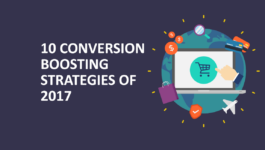Ecommerce is a rapidly expanding business niche, with numerous brands marketing an endless range of products and services for all types of target audience. Providing outreach to international audience without requiring a physical store with nominal investment, almost every brand has a web store for capitalizing on the immeasurable potential of ecommerce. Online shopping provides customers the facility to select their desired products and services from the convenience of their location, which has made it a popular choice among customers.
With ecommerce retails in US predicted to reach $460 billion in 2017, it is evident that it will continue to be a profitable venture and optimizing for conversions is mandatory for your ecommerce store to surpass competitors. The following 10 ecommerce tips are derived by analyzing trends in 2017 and are designed to optimize conversions for higher revenue:
1. A/B Testing for Checking Acceptance
Content acceptance is the key for unlocking increased traffic and higher conversion rates. Rather than simply integrating changes into your live ecommerce store, create variants based on selected changes and divide them accordingly for the incoming traffic to view. The site metrics will prove which version scored higher acceptance and conversion rates to prove their feasibility. Because A/B testing yields case specific results for changes, it is perfectly suited for deriving which changes will positively affect conversions as compared to relying solely on statistical data or studying results of other cases.
2. Self-Explanatory Product Descriptions
One of the leading reasons for fall in conversion rates is ambiguous products and services descriptions that leads to complications in selecting and purchasing items. Create content which will both clarify information regarding what is being offered and convince customers to purchase from your ecommerce store rather than competitors. Search engine optimization is critical through content for search engine relevancy and subsequently SERP rakings for attracting higher traffic, enhancing visibility and the number of potential customers visiting the web store.
3. Managing Shipping Costs
Shipping costs often lead to customers searching competitors for the least possible costs. Moreover, majority of web stores do not display or add shipping costs till the very end of checkout when the customer has selected their purchases, leading to cart abandonment since the overall cost suddenly increases, exceeding the predefined amount customers are willing to spend.
While free shipping for every kind of order may not be feasible, introduce limits beyond which shipping fee will not be charged. Clearly define shipping costs for facilitating customers to plan their purchases beforehand, which will consequently reduce cart abandonment.
4. Return Policy
Since there is a general perception the product will vary from how it appears on the web store, customers have reservations when shopping online. Having a return/refund policy for products and services reinforces customer trust that the store assumes responsibility for their purchases and can be returned even if they are unsatisfactory, leading to a higher number of sales. Clearly state the return/refund policy at the beginning and end of checkout to avoid inconvenient situations from arising which can tarnish brand reputation and will ultimately reduce conversions.
5. Email Marketing through Confirmation Emails
A confirmation email is sent to the customer account to inform about online purchase which contains information regarding selected products and services. The email holds tremendous potential for marketing as it can be modified to include recommended items or even discounted ones available as a result of the purchase.
Customers generally view their emails to ensure the order is confirmed and the content related to their purchases naturally captivates attention. Including discount coupons, redeemable codes or special offers upon next purchase encourages a follow up purchase, which is an excellent strategy to create repeat customers.
- Mobile Emails
By 2018, it is estimated that 80 percent users will access emails through mobiles and 70 percent will not view those which are not mobile optimized. As the number of mobile users continues to increase and brands adopt a mobile first approach, modifying your marketing strategy will enable seamless adjustment with shifting customer and business trends.
6. Optimizing Checkout and Payment
The checkout is the lifeline of ecommerce, where the last step of purchase is finalized, hence modifying it to suit trends is essential for achieving maximum conversions. Following are the latest trends favored by brands and customers:
- Offering Multiple Payment and Shipping Services
When targeting international audience, the region and payment options vastly vary, so include multiple payment and shipping options. The timeline for delivery also varies between regions, so include options to select delivery method and service for customers. Online payment gateways such as PayPal and Google Wallet are trending and adding them to your checkout will open options for many customers to use their existing accounts for transactions.
- Display Information During Each Step:
Keep customers updated about their checkout details during each step so they can revise their decisions if necessary. Product quantity, type, total payment and shipping details are all necessary for the customer to finalize their checkout
- Custom Order Attributes
Add custom order attributes to stream line input fields and get specific details from customer. You can this feature through modules such as Magento Order Attributes extension which allows you to add custom fields according to merchant preferences along with several other options.
- Changing Order During Checkout
Customers often have second thoughts about purchases and seek to change their existing order. Include features to go back to previous checkout steps and modify cart contents to provide customers satisfaction that their order is exactly according to their demands.
7. Real Time Help and Support
Ecommerce stores retail a vast inventory of products and services, which can distract customer from purchasing their desired ones. Moreover, customers often have inquiries regarding their purchases before finalizing them. Incorporating real time help and support provides customers the facility to immediately send their queries and receive prompt answers, which enables decision making with clarity.
A live customer feedback module demonstrates that the brand cares about user purchases and have dedicated resources to assist them by providing relevant solutions to queries. While the chat encompasses significant potential to develop customer trust and enhance user experience, care should be taken regarding response time. Chances of site abandonment increase drastically by the second that the customer is put on hold.
8. Mobile Optimization
Ecommerce has rapidly shifted to mobile devices and even Google has adopted a mobile first approach for their SERP rankings. With 80 percent internet users owning a mobile device and their transactions estimated to reach 2 billion users internationally by the end of 2017, optimizing for mobiles is essential for catering to a significant portion of potential customers. (source)
Following are a few major issues which can boost conversions through mobile platforms:
Mobile Adaptability
The ecommerce store should be designed to adapt on mobile devices without distorting on-site elements and features. Rigorously test that the images, text and theme do not lose quality or formatting when deployed on mobile otherwise the user experience will be compromised. Confirm that the checkout displays all relevant features for a streamlined experience allows users to keep track of each step during the process.
Loading Speed
Slow website loading speed can result in as high as 75 percent cart abandonment, which drastically reduces the number of total potential leads. With 47 percent users preferring a maximum loading time of 2 seconds, it is preferable to prioritize loading of key elements for viewing first to provide users facility to begin browsing for their desired items and continuing the rest in the background.
9. Include Customer Feedback
Customers are more trusting of feedback regarding items given by their peers as compared to the description provided by brands because they have been tested by fellow users and their feedback is absent of sales intent. Displaying customer feedback strengthens customer trust that their selected item is devoid of faults because other buyers have stated a positive experience.
10. Accepting Partial Payments
Allow customers to make an initial deposit to confirm order and to clear the outstanding balance later before shipping. At times the customer may have insufficient funds to complete transaction but will later pay the dues. Providing promotional offers and discounts also encourages additional purchases, leading to not only higher conversions but greater revenue returns. You can also incorporate a layaway module such as Magento Partial Payment extension that allows customers to purchase products from online stores in installments.
Adapting Conversion Strategies with Trends
Conversions are the health indicators for an ecommerce store and are directly proportional to their performance and success. By implementing these 10 techniques in your ecommerce store, you can benefit from the edge necessary for overcoming competition and gaining higher conversions for greater revenue.








